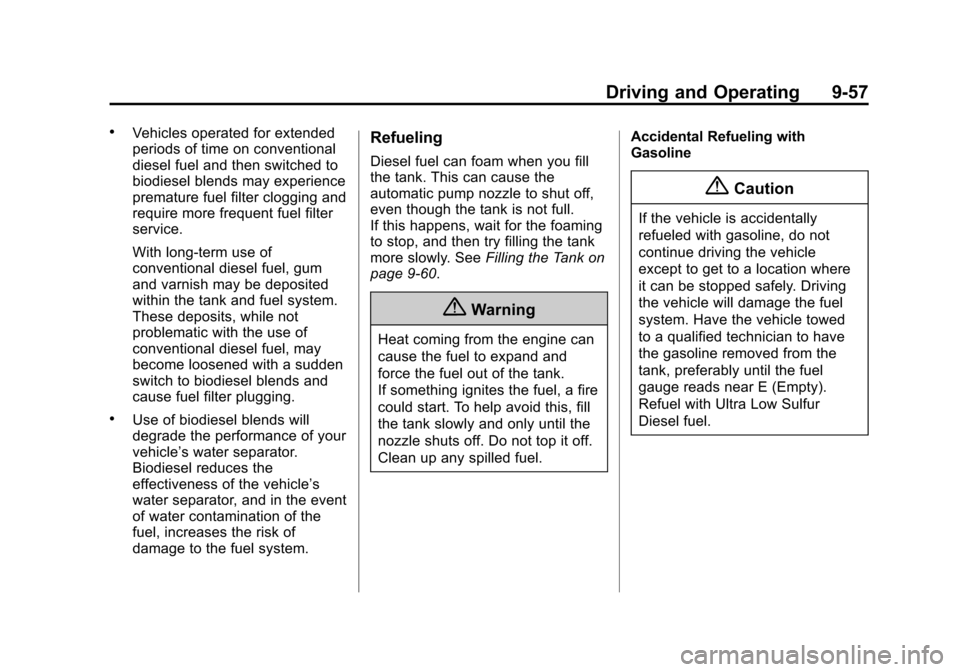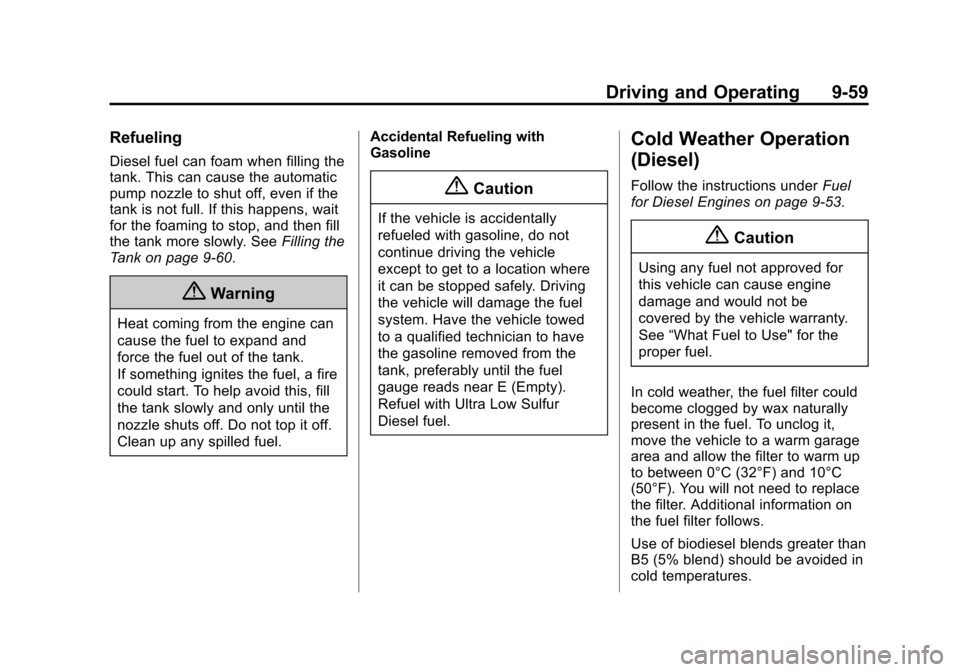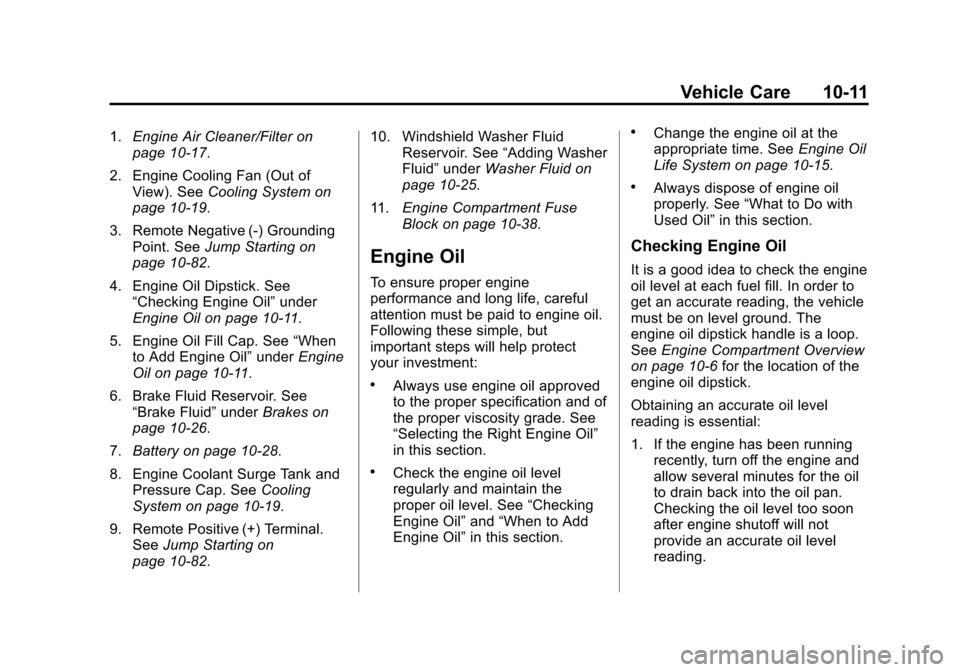Page 248 of 417

Black plate (57,1)Chevrolet Cruze Owner Manual (GMNA-Localizing-U.S./Canada-7707493) -
2015 - crc - 11/24/14
Driving and Operating 9-57
.Vehicles operated for extended
periods of time on conventional
diesel fuel and then switched to
biodiesel blends may experience
premature fuel filter clogging and
require more frequent fuel filter
service.
With long-term use of
conventional diesel fuel, gum
and varnish may be deposited
within the tank and fuel system.
These deposits, while not
problematic with the use of
conventional diesel fuel, may
become loosened with a sudden
switch to biodiesel blends and
cause fuel filter plugging.
.Use of biodiesel blends will
degrade the performance of your
vehicle’s water separator.
Biodiesel reduces the
effectiveness of the vehicle’s
water separator, and in the event
of water contamination of the
fuel, increases the risk of
damage to the fuel system.
Refueling
Diesel fuel can foam when you fill
the tank. This can cause the
automatic pump nozzle to shut off,
even though the tank is not full.
If this happens, wait for the foaming
to stop, and then try filling the tank
more slowly. See Filling the Tank on
page 9-60.
{Warning
Heat coming from the engine can
cause the fuel to expand and
force the fuel out of the tank.
If something ignites the fuel, a fire
could start. To help avoid this, fill
the tank slowly and only until the
nozzle shuts off. Do not top it off.
Clean up any spilled fuel. Accidental Refueling with
Gasoline
{Caution
If the vehicle is accidentally
refueled with gasoline, do not
continue driving the vehicle
except to get to a location where
it can be stopped safely. Driving
the vehicle will damage the fuel
system. Have the vehicle towed
to a qualified technician to have
the gasoline removed from the
tank, preferably until the fuel
gauge reads near E (Empty).
Refuel with Ultra Low Sulfur
Diesel fuel.
Page 250 of 417

Black plate (59,1)Chevrolet Cruze Owner Manual (GMNA-Localizing-U.S./Canada-7707493) -
2015 - crc - 11/24/14
Driving and Operating 9-59
Refueling
Diesel fuel can foam when filling the
tank. This can cause the automatic
pump nozzle to shut off, even if the
tank is not full. If this happens, wait
for the foaming to stop, and then fill
the tank more slowly. SeeFilling the
Tank on page 9-60.
{Warning
Heat coming from the engine can
cause the fuel to expand and
force the fuel out of the tank.
If something ignites the fuel, a fire
could start. To help avoid this, fill
the tank slowly and only until the
nozzle shuts off. Do not top it off.
Clean up any spilled fuel. Accidental Refueling with
Gasoline
{Caution
If the vehicle is accidentally
refueled with gasoline, do not
continue driving the vehicle
except to get to a location where
it can be stopped safely. Driving
the vehicle will damage the fuel
system. Have the vehicle towed
to a qualified technician to have
the gasoline removed from the
tank, preferably until the fuel
gauge reads near E (Empty).
Refuel with Ultra Low Sulfur
Diesel fuel.
Cold Weather Operation
(Diesel)
Follow the instructions under
Fuel
for Diesel Engines on page 9-53.
{Caution
Using any fuel not approved for
this vehicle can cause engine
damage and would not be
covered by the vehicle warranty.
See “What Fuel to Use" for the
proper fuel.
In cold weather, the fuel filter could
become clogged by wax naturally
present in the fuel. To unclog it,
move the vehicle to a warm garage
area and allow the filter to warm up
to between 0°C (32°F) and 10°C
(50°F). You will not need to replace
the filter. Additional information on
the fuel filter follows.
Use of biodiesel blends greater than
B5 (5% blend) should be avoided in
cold temperatures.
Page 270 of 417

Black plate (11,1)Chevrolet Cruze Owner Manual (GMNA-Localizing-U.S./Canada-7707493) -
2015 - crc - 11/24/14
Vehicle Care 10-11
1.Engine Air Cleaner/Filter on
page 10-17.
2. Engine Cooling Fan (Out of View). See Cooling System on
page 10-19.
3. Remote Negative (-) Grounding Point. See Jump Starting on
page 10-82.
4. Engine Oil Dipstick. See “Checking Engine Oil” under
Engine Oil on page 10-11.
5. Engine Oil Fill Cap. See “When
to Add Engine Oil” underEngine
Oil on page 10-11.
6. Brake Fluid Reservoir. See “Brake Fluid” underBrakes on
page 10-26.
7. Battery on page 10-28.
8. Engine Coolant Surge Tank and Pressure Cap. See Cooling
System on page 10-19.
9. Remote Positive (+) Terminal. See Jump Starting on
page 10-82. 10. Windshield Washer Fluid
Reservoir. See “Adding Washer
Fluid” under Washer Fluid on
page 10-25.
11. Engine Compartment Fuse
Block on page 10-38.
Engine Oil
To ensure proper engine
performance and long life, careful
attention must be paid to engine oil.
Following these simple, but
important steps will help protect
your investment:
.Always use engine oil approved
to the proper specification and of
the proper viscosity grade. See
“Selecting the Right Engine Oil”
in this section.
.Check the engine oil level
regularly and maintain the
proper oil level. See “Checking
Engine Oil” and“When to Add
Engine Oil” in this section.
.Change the engine oil at the
appropriate time. See Engine Oil
Life System on page 10-15.
.Always dispose of engine oil
properly. See “What to Do with
Used Oil” in this section.
Checking Engine Oil
It is a good idea to check the engine
oil level at each fuel fill. In order to
get an accurate reading, the vehicle
must be on level ground. The
engine oil dipstick handle is a loop.
SeeEngine Compartment Overview
on page 10-6 for the location of the
engine oil dipstick.
Obtaining an accurate oil level
reading is essential:
1. If the engine has been running recently, turn off the engine and
allow several minutes for the oil
to drain back into the oil pan.
Checking the oil level too soon
after engine shutoff will not
provide an accurate oil level
reading.